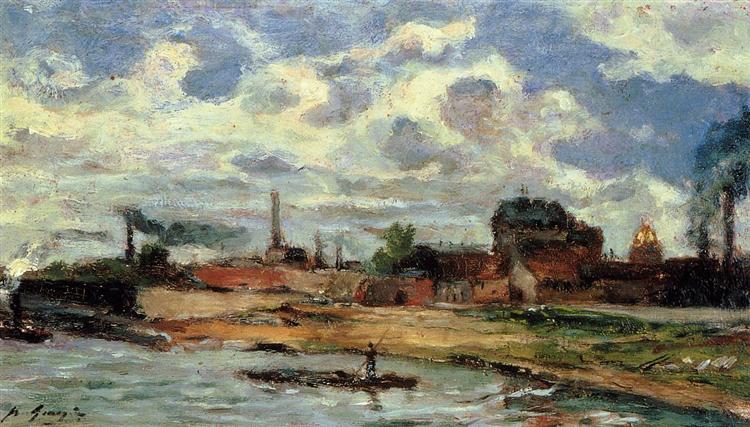Descrizione
Paul Gauguin's painting "Port de Javel", painted in 1876, is part of the pictorial tradition of French realism, but already anticipates certain characteristics that would be developed more fully in his later work. In this oil on canvas, Gauguin offers a vivid representation of the port in which elements of urban life and nature are intertwined, a recurring theme in late 19th-century painting.
The composition reveals a meticulous attention to the construction of space. The visual loads are balanced between the anchored boats, whose distinctive shapes establish a dialogue with the gentle undulations of the water. The horizon, with its clear division between sky and sea, is crucial in this work. The blue tones of the water contrast with the warm hues that dominate the land and the boats, creating an atmosphere that evokes both serenity and movement.
Colours play a fundamental role in Port de Javel. The palette used by Gauguin, although more sober compared to his later works, still shows his ability to balance contrasts. The warm tones of the boats are intertwined with the greens of the surrounding vegetation. This use of colour does not simply seek representation, but induces an emotion, suggesting the vitality of the scene and, at the same time, a certain melancholy that can be glimpsed in the tonality of the sky.
The human figure is subtle in this work, as there are no characters in a conventional sense, but there is a strong presence of human activity through the vessels and the infrastructure of the port. The vessels, often the symbol of connection to the world and trade, seem almost like characters in themselves, with their imposing silhouettes and tethers connecting the viewer to the daily life of the time. The depiction of the maritime industry, a pillar of the French economy at the time, can be interpreted as a recognition of the interdependence between men and their environments.
An interesting aspect of "Port de Javel" is its historical context. Painted during a transitional period in Gauguin's life, this work reflects his early exploration in the use of shapes and colors that would eventually chart his path toward post-impressionism and symbolism. As he moved away from the realisms of his day, "Port de Javel" can be seen as marking a step toward the emotional abstraction that would define his later works.
Compared to other artists of his time, such as Camille Pissarro or Alfred Sisley, Gauguin moves into a more contemplative rhythm, moving away from the frenetic and fleeting approach of Impressionism. "Port de Javel" is presented as a more grounded study, where the observer is invited to experience not only the scene, but also the sense of belonging to a specific time and place.
In short, Paul Gauguin’s “Port de Javel” is a work that, while anchored in realist representation, suggests a transition to a more emotional and subjective interpretation of reality. The composition, the use of color, and the almost absent, yet palpable human presence, articulate a strong sense of place and time. This oil painting, both revered and studied, marks an important chapter in the artist’s trajectory, pointing toward the bolder explorations that would define his career. The qualities Gauguin establishes in this early work resonate throughout his creative life, inviting viewers into a world where art is a mirror of intense and immediate experiences.
KUADROS ©, a famous painting on your wall.
Hand-made oil painting reproductions, with the quality of professional artists and the distinctive seal of KUADROS ©.
Painting reproduction service with satisfaction guarantee. If you are not completely satisfied with the replica of your painting, we will refund 100% of your money.

